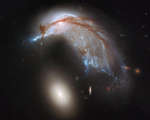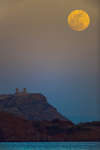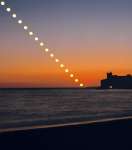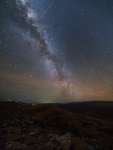
|
Astronomy Picture Of the Day (APOD)
 The Porpoise Galaxy from Hubble
The Porpoise Galaxy from Hubble
24.06.2013
What's happening to this spiral galaxy? Just a few hundred million years ago, NGC 2936, the upper of the two large galaxies shown, was likely a normal spiral galaxy -- spinning, creating stars -- and minding its own business.
 Venus Once Molten Surface
Venus Once Molten Surface
23.06.2013
If you could look across Venus with radar eyes, what might you see? This computer reconstruction of the surface of Venus was created from data from the Magellan spacecraft. Magellan orbited Venus and used radar to map our neighboring planet's surface between 1990 and 1994.
 Perigee s Full Moon
Perigee s Full Moon
22.06.2013
A big, bright, beautiful Full Moon will rise at sunset on Sunday. Its exact full phase (June 23, 11:32 UT) will occur shortly before it reaches perigee, the closest point to Earth in the Moon's orbit, and make it the largest Full Moon of 2013. But such circumstances are not very rare.
 A Solstice Sunset Self Portrait
A Solstice Sunset Self Portrait
21.06.2013
Today, the solstice is at 05:04 Universal Time, the Sun reaching the northernmost declination in its yearly journey through planet Earth's sky. A June solstice marks the astronomical beginning of summer in the northern hemisphere and winter in the south.
 Edge on NGC 3628
Edge on NGC 3628
20.06.2013
Sharp telescopic views of magnificent edge-on spiral galaxy NGC 3628 show a puffy galactic disk divided by dark dust lanes. Of course, this deep galactic portrait puts some astronomers in mind of its popular moniker, The Hamburger Galaxy.
 Milky Way Over Crater Lake with Airglow
Milky Way Over Crater Lake with Airglow
19.06.2013
How many different astronomical phenomena have come together to create the above vista? Several. First, in the foreground, is Crater Lake -- a caldera created by volcanism on planet Earth about 7,700 years ago. Next, inside the lake, is water.
 A Supercell Thunderstorm Over Texas
A Supercell Thunderstorm Over Texas
18.06.2013
Is that a cloud or an alien spaceship? It's an unusual and sometimes dangerous type of thunderstorm cloud called a supercell. Supercells may spawn damaging tornados, hail, downbursts of air, or drenching rain. Or they may just look impressive.
 Dry Ice Sled Streaks on Mars
Dry Ice Sled Streaks on Mars
17.06.2013
What creates these long and nearly straight grooves on Mars? Dubbed linear gullies, they appear on the sides of some sandy slopes during Martian spring, have nearly constant width, extend for as long as two kilometers, and have raised banks along their sides.
 APOD Turns Eighteen
APOD Turns Eighteen
16.06.2013
The first APOD appeared eighteen years ago today, on 1995 June 16. Although garnering only 14 pageviews on that day, we are proud to estimate that APOD has now served over one billion space-related images over the past eighteen years.
 Delphinid Meteor Mystery
Delphinid Meteor Mystery
15.06.2013
Over a five hour period last Tuesday morning, exposures captured this tantalizing view of meteor streaks and the Milky Way in dark skies above Las Campanas Observatory in Chile. During that time, astronomers...
|
January February March April May June July August September October November December |
|||||||||||||||||||||||||||||||||||||||||||||||||